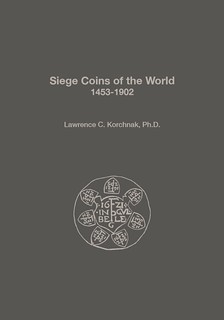
PREV ARTICLE
NEXT ARTICLE
FULL ISSUE
PREV FULL ISSUE
NEW BOOK: SIEGE COINS OF THE WORLD 1453-1902My friend Larry Korchnak has collected and studied siege coins since 1972; CNG has published his long-awaited book on the topic. Over 375 coins illustrated in the book are from his personal collection. It will be available after July 8, 2021. With permission, here are excerpts from the book's Foreword and Introduction. Congratulations! -Editor
Introduction In siege warfare, towns and cities were routinely surrounded by hostile forces and cut off from the outside world. Soldiers battled fiercely for their cause, their lives, and their honor. Historical accounts of the battles between besieger and defender reflect the basest as well as the most sublime aspects of human nature. For example, during one of the sieges of Vienna, the Turks demonstrated their skill in crude psychological warfare by impaling captive Austrians on poles in clear view of defending forces. In contrast, a commanding officer in one Dutch siege exhorted his starving men to hold fast against the Spanish besiegers until help arrived by offering to sacrifice his arm as food. During these encounters, the armies involved in battle were predominately mercenaries, soldiers who were paid to defend or lay siege to a particular city or fortress. They were paid in coin of the realm until the money ran out. When the siege extended beyond the existing supply of ready cash, additional money was needed to secure the services of the men. Hence, siege money was created to fill the void.
Not surprisingly, the technical term for siege is obsidional, derived from the Latin word, obsidere, meaning 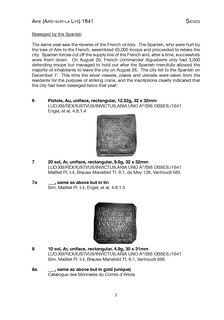
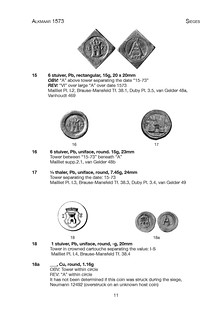
While siege money is emergency or necessity money, not all emergency or necessity money is siege money. Provisional coinage and money issued during transitions of sovereignty and monetary shortages are not siege money. For example, Mallorca produced the 1821 five pesetas during a quarantine of the island due to an epidemic of yellow fever. Also, in instances of economic instability, coins were sometimes counterstamped to indicate a change in value. However, while these extreme conditions produced emergency money, only sieges produce obsidional money. Foreword I began collecting siege money many years ago after acquiring a 1621 Julich four stuiver from a local coin dealer. The irregularly shaped coin sparked my interest and I wanted to learn more. However, when I began my search for information, I discovered that there were no catalogues and very few articles in English on the subject. Since this was pre-internet, my only avenue of research was to seek the available numismatic reference works in Latin and multiple European languages. Many of these references were difficult to find. However, once I found them, I added them to my library and discovered that each was incomplete on its own due to the complexity of the subject matter and the information available at the time of their publication. So, I began a numismatic journey that led me to this project. Siege Coins of the World. Siege Coins of the World is the result of translating the major works, merging their content, and updating the most recent information available into a single volume. It is an attempt to expand the knowledge of this fascinating area of numismatics and create a comprehensive English language reference for the collector. Siege Coins of the World intentionally excludes fantasies and issues that are more appropriately categorized as necessity coins, such as Cartagena, Montalcino, La Rochelle, and Spanish local issues. Conversely, those generally accepted by the numismatic community as siege coins are included, such as Groningen, Thorn, and the Irish cities of refuge. Most, but not all, known varieties of each type are listed. The reader can find these varieties in specialized catalogues that are noted in the Selected Bibliography. 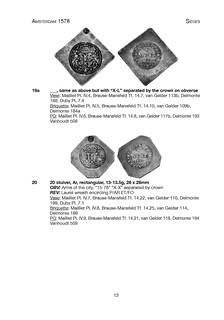
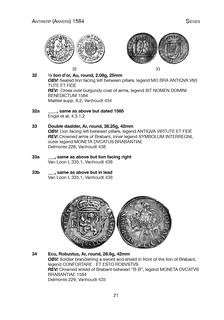
In Siege Coins of the World, sieges are arranged in alphabetical order for easy reference. There is a brief description of each siege to provide the reader with historical context followed by a list of coins known to be issued as a result of the siege. Siege Coins of the World has assigned a uniform numbering system and cross references to other cited sources. Coins that were missing from earlier works and major varieties that have since been confirmed have been added. Illustrations accompany the descriptions and line drawings are provided where no photograph was available. The reader should note that while the author has made every effort to provide precise specifications for each coin, slight variances in size and weight are not uncommon.
For more information, or to order, see:
Wayne Homren, Editor The Numismatic Bibliomania Society is a non-profit organization promoting numismatic literature. See our web site at coinbooks.org. To submit items for publication in The E-Sylum, write to the Editor at this address: whomren@gmail.com To subscribe go to: https://my.binhost.com/lists/listinfo/esylum All Rights Reserved. NBS Home Page Contact the NBS webmaster 
|
